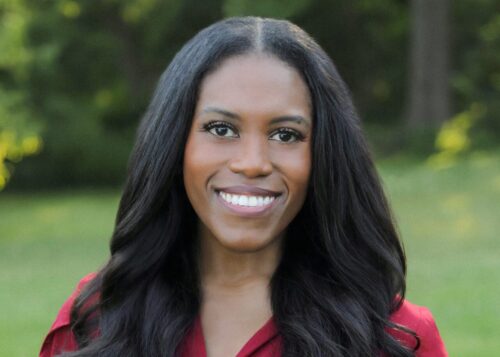How Can Leaders in Academic Medicine Make Career Advancement More Equitable?
January 6, 2022
By David Limm

Getty Images
To address gender and racial disparities in the higher ranks, an advisory group from Boston University Medical Group created a toolkit to make promotion inclusive and fair.
Gender parity in leadership roles within academic medicine is growing but at a sluggish pace—especially for women of color. According to a 2018 report from the Association of American Medical Colleges, while the number of department chairs and deans has risen, only 18% of those leadership positions are occupied by women—a change of just 5% and 6%, respectively, from a decade earlier. That women make up 41% of faculty only underscores the gap.
In 2019, members of the Women’s Leadership Advisory Council at Boston University Medical Group (BUMG) set out to bring greater parity to faculty leadership at Boston Medical Center and Boston University School of Medicine, where BUMG members practice, teach, and conduct research. Their mission to help clinical department leaders create an open culture around career advancement is one that’s committed to gender equity as well as racial and ethnic equity.
The council focused its efforts on reforming the often veiled and informal nature of faculty leadership appointments. The result of that work is the Review-Based Guidelines for the Equitable Appointment of Leadership Roles, a blueprint for departments to build an internal selection process that is inclusive, transparent, and fair.
Adapting recommendations on external hiring practices to the needs of clinical departments, the guidelines are a starter kit full of practical advice and strategies, worksheets to use for tracking progress, as well as sample job descriptions and interview questions. The authors even break down the work of implementing the guidelines into four digestible steps.
While the guidelines were written with BUMG in mind, the information contained in them is broadly applicable and can be harnessed by department leaders at any academic medical center. Indeed, much of the strategies and advice can serve any leader or manager looking to make the process of promoting from within more equitable.
HealthCity spoke with Megan Bair-Merritt, MD, MSCE, a pediatrician and chair of BUMG’s Women’s Leadership Advisory Council, about the creation of the guidelines and what happens when departments lack a formal process that’s accessible to all.
HealthCity: Why were the Review-Based Guidelines for the Equitable Appointment of Leadership Roles created?
Megan Bair-Merritt, MD, MSCE: The rationale behind creating the review-based guidelines, affectionately called RBG, was that, if you look at data—for example, gender data on who is attending medical school—it’s been about 20 years that women have made up about half of medical school classes. And yet, as you go through and look at the percentage of women who are in leadership positions, that number is really, really small. For chairs, only around 10% to 20% of positions across the country are filled by women, and it’s even smaller if you look at deans. Then, if you look at all leadership positions, there are similar patterns. And similar patterns also exist with underrepresentation for faculty of color.
Often, rather than having an open process where a call for applications is widely publicized to search for internal leadership positions, people in leadership turn around and tap somebody on the shoulder. That often tends to be somebody who may have had access to those positions, versus opening it up for a wider pool of applicants.
The goal is that every department across BUMG will move toward having an established process for the assignment of leadership positions that meets some of the core components that are laid out in the RBG.
HC: In writing these guidelines, why did the Women’s Leadership Advisory Council, specifically, decide to take into account people of color, including men?
MBM: There’s substantive data on the benefit, whether it is for patient outcomes or for scientific inquiry, of having diverse faces at the table. That is true of many different identities. Although this originated in the Women’s Leadership Advisory Council, I think there was recognition of this as being an important mechanism to foster diversity more broadly.
HC: What are some of the obstacles to advancement and obtaining leadership roles that women and people of color face?
MBM: Historically, leadership positions are filled without a process, in part because of time pressures. There’s a lot of literature that shows women and faculty of color less often have mentors and sponsors that help in promoting career development opportunities. Department leaders should seek out mentoring relationships and start conversations about career and leadership goals early on. By sponsoring faculty to join different professional societies, nominating them for awards or positions, and encouraging them to engage in career development or to assume leadership positions, leaders can help women and people of color be better positioned to advance in their careers.
HC: Why isn’t there more research on best practices for conducting an equitable internal process for leadership selection?
MBM: I don’t know for sure. We spent a long time going through and searching the medical literature and the literature in other fields. The field that has the most information is business. Businesses, more than medicine, have thought about equity in leadership positions, so we searched there. We also searched peer institutions and asked about their practices.
Most often there’s information or data or best practices around external searches, which I think makes sense. There’s less attention paid to what happens when there is a leadership position that one does not do an external search for despite these positions being instrumental. Having similar processes to what one would recommend for external searches is really important, because it allows you to be more inclusive in who fills those positions.
HC: Does the lack of a consistent process make the problem of underrepresentation worse?
MBM: I think it’s a contributor, for sure. If you think, for example, about retention when people leave, one of the reasons they leave is because they don’t see leadership pathways for themselves at their current institution. When you have a position that needs to be filled quickly, often people end up in the position without a standardized process, which may hinder the ability to fill these positions with diverse candidates. When organizations skip a standard appointment process, it leads to a culture that doesn’t have transparency. The lack of a process hurts your ability to retain talented people. It leads to a feeling among employees that there’s not an equitable climate, and people don’t feel the same sense of belonging.
“One of the things we talk about as a best practice is having a standing leadership search committee that has done some implicit bias training and has a diversity advocate, in part to be able to call out or question if somebody says, ‘Well, this person is not a good fit.'”
One thing departments in our pilot program do is send their faculty and trainees a list of all of the leaders in the department. By naming who is in leadership positions, trainees and people who are earlier in their careers can connect with those people. As you start to build in that transparency and that understanding, you open up opportunities for leadership across the board.
HC: You write in the guidelines that the phrase “this person is not a good fit” is often code for “this person isn’t like me.” You also advise excluding the words “exceptional” and “distinguished” from the job description, because words like that are known to discourage women and all people from underrepresented groups from applying.
MBM: We all have biases that we bring to decision-making. These biases, however, if left unchecked, can lead to discrimination or different standards for different candidates. For example, I have observed that women candidates are subject to biases related to work-life balance. People question if they have the time or bandwidth for a leadership position in a way that is not considered or worried about for male candidates. Having some intentionality around pausing, questioning those potential biases and how they are entering into decision-making is helpful.
One of the things we talk about as a best practice is having a standing leadership search committee that has done some implicit bias training and has a diversity advocate, in part to be able to call out or question if somebody says, “Well, this person is not a good fit.”
HC: Skeptics, including some who may be the target demographic of diversity and inclusion initiatives, might think that this is motivated more by optics than change. How was the process designed to build trust among the faculty so they see the program as worth the investment of time and effort?
MBM: Truthfully, that takes time. People have to see that it’s not just being done as an exercise, that people are actually using it, it’s actually making change and bringing highly qualified people with diverse identities into leadership roles.
HC: Five departments have already worked on piloting the guidelines. What has the response been?
MBM: Family Medicine, Neurology, and Pathology were the first three that piloted implementation of the RBG. That expanded to also include OB/GYN and Pediatrics in the next wave.
We’ve had to be upfront with departments that implementing these guidelines really takes time to do. And nobody has any time, particularly with the COVID-19 pandemic. It takes time for the leadership of the department. It takes time for the people who become part of the standing leadership search committee.
Once we went through all that though, we did some reviews and received feedback. People reported that this felt like a really valuable process and use of time. They were able to have difficult conversations about how things were done before. Or they perceived they were doing things well and then found new opportunities, had a lot of open conversations about their own biases and perceptions going into these searches, and things that they thought they could do differently moving forward. There’s been an overwhelming, positive response.



